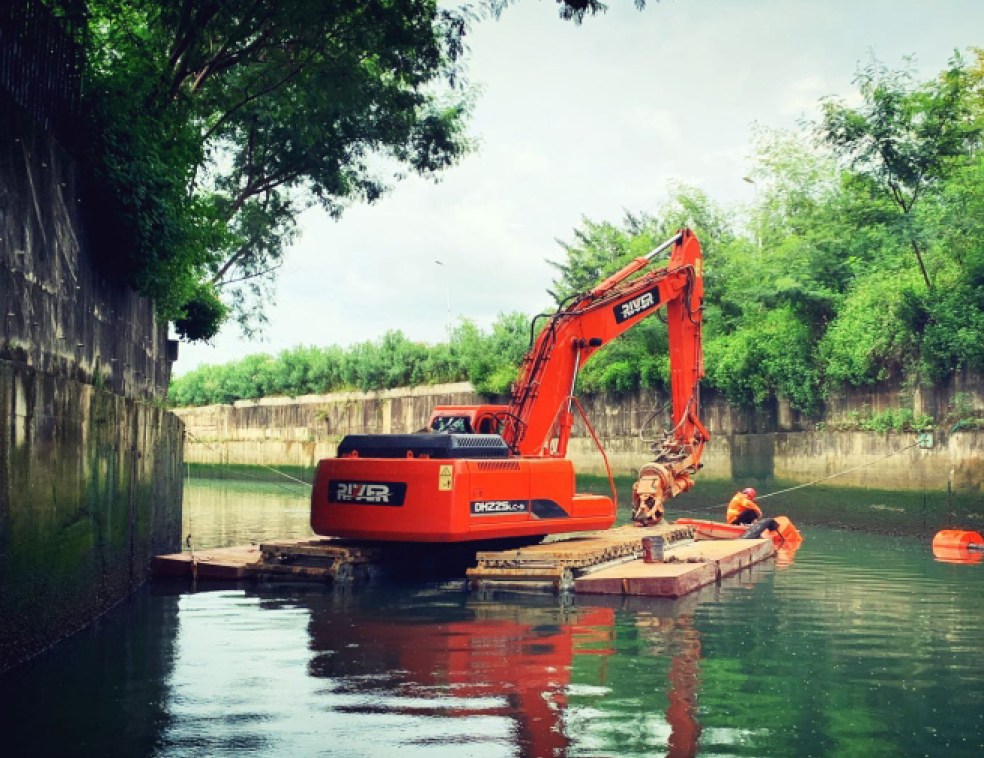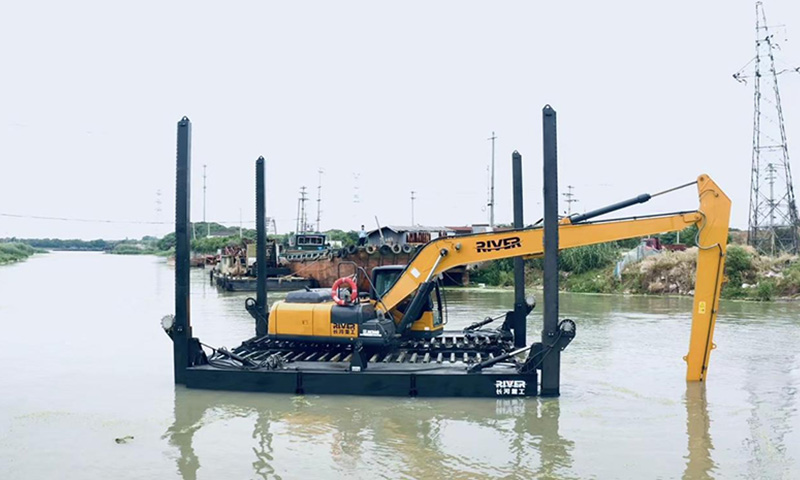Are you intrigued by the unique capabilities of pontoon excavators and curious about how they operate in marshy terrain and shallow waters? In this post, we will delve into the fascinating world of pontoon excavators, exploring their innovative design and mechanics that allow them to excel in wetland restoration, dredging, and shoreline construction projects.
Join us as we unravel the workings of pontoon excavators, discussing their buoyant pontoons, amphibious mobility, and integrated hydraulic systems. In this post, you’ll discover how these specialized machines leverage their unique features to navigate challenging environments.
What is a Pontoon Excavator?
A pontoon excavator is an amphibious machine that is specifically crafted to operate in swampy areas and other types of wet environments. This type of excavator is mounted on a pair of pontoons, which provide the necessary flotation and stability to perform excavation tasks on soft terrain, in water, or near water bodies. The design of the pontoons allows the machine to navigate and work in conditions that would typically hinder traditional land-based excavators.
The equipment is fitted with a conventional excavator upper structure, which houses the engine, operator cabin, and boom arm with an attached bucket or other tools. This configuration enables the pontoon excavator to perform a wide range of tasks, such as digging, dredging, and material handling, just like its land-based counterparts but with the added ability to operate on water.
Due to its unique design, a pontoon excavator is often the go-to choice for projects that require access to challenging terrains. Its floating capabilities and specialized attachments allow for efficient and safe operations in areas that are not just wet but also environmentally sensitive, where preserving the integrity of the ecosystem is of utmost importance.
Features of a Pontoon Excavator
Pontoon excavators are known for their buoyancy through hermetically sealed pontoons, allowing the excavator to float. Their features include efficiency and stability over a wider range of terrains, adaptability to perform tasks for different industrial applications, and a robust hydraulic system. The pontoon undercarriage, track chains, and design focus on stability and safety making them a versatile and reliable choice for various projects.
Versatility
The versatility of pontoon excavators is evident in their ability to perform a wide array of tasks across different environments. From dredging to environmental remediation, these machines can be outfitted with a range of attachments to handle specific job requirements, showcasing their adaptability and utility in the field.
Environmentally Friendly
These machines exert minimal pressure on the ground, reducing the risk of environmental damage in sensitive ecosystems. They are suitable for conservation projects where the preservation of the natural landscape is critical.
Cost-Effective
By reducing the number of machines needed for a project and the associated logistical costs, pontoon excavators offer a more economical solution for operations in challenging environments.
Improved Safety
Pontoon excavators offer an environmentally friendly option that minimizes ground pressure and habitat disruption. They are cost-effective by reducing the need for additional equipment and improving operational efficiency. Safety is also enhanced, as the stable platform decreases the risk of accidents in challenging conditions.
Accessibility
The unique design of pontoon excavators allows them to access remote or waterlogged sites that are otherwise unreachable, enhancing their utility in a diverse range of projects.
Efficiency
By combining the functions of a boat and an excavator, these machines eliminate the need for additional equipment to transport materials across the water, streamlining the workflow and saving time.
Versatility
Pontoon excavators can adapt to various terrains, including marshes, shallow lakes, and riverbeds. Their ability to float and maneuver in water makes them ideal for tasks that regular excavators cannot perform.
Applications of a Pontoon Excavator
Pontoon excavators have become a staple in the construction industry, particularly for flood and disaster recovery efforts and dredging tasks. Their ability to navigate and work in aquatic settings makes them invaluable for projects that span across both land and water interfaces, delivering solutions that would otherwise be difficult or impossible to achieve with standard equipment.
Dredging and Waterway Maintenance
In wet environments, pontoon excavators with an amphibious undercarriage are essential for maintaining the navigability and health of waterways. By removing accumulated silt, debris, and vegetation, these machines ensure waterways remain clear for transportation and prevent flooding. Their design allows them to perform these dredging tasks efficiently, with minimal disturbance to the aquatic ecosystem.
Wetland Restoration
The restoration of wetlands requires delicate handling and precision, which is where pontoon excavators shine. With their amphibious undercarriage, they can traverse wet environments, reposition soil, and move vegetation without causing significant disruption to the habitat, aiding in the conservation and rehabilitation of these crucial ecological areas.
Shoreline Construction and Maintenance
Often referred to as marsh buggies, pontoon excavators are instrumental in constructing and maintaining shorelines. Their ability to maneuver in shallow waters and marshy conditions allows them to build sea walls, repair erosion damage, and create natural barriers, providing essential support for coastal communities and ecosystems.
Flood Control and Drainage Projects
Pontoon excavators are critical tools for managing water levels and preventing flooding. Their ability to operate in inundated areas enables them to construct levees, clear blockages in drainage channels, and reshape landscapes to improve water flow, contributing to the overall resilience of flood-prone regions.
Environmental Remediation
Environmental remediation tasks in aquatic settings often call for the unique capabilities of pontoon excavators. They are used to remove contaminated sediments and invasive species, and to assist in the restoration of natural water filters, playing a vital role in the recovery of polluted water bodies and wetlands.
Utility and Pipeline Installation in Wet Areas
Laying utilities and pipelines in wet areas poses significant challenges, but pontoon excavators are equipped to handle such tasks. They provide a stable platform for digging trenches and laying pipes in swamps and along shorelines, ensuring the infrastructure is installed correctly without compromising the integrity of the environment.
How Does a Pontoon Excavator Work?
Pontoon excavators are designed with a unique combination of attributes inherited from amphibious buggies and conventional excavators. These pieces of excavation equipment allow excavators to operate in shallow water areas, providing capabilities that surpass those of standard excavators.
The specialized design enables them to navigate through challenging environments like swamps, marshes, and industrial waste ponds, handling tasks such as dredging and vegetation clearing with ease. The pontoon excavators work in the following ways:
Amphibious Capability
Pontoon excavators are part of a broader category of wetland equipment that is increasingly popular in North America and Europe. This equipment is often used in construction projects that require access to difficult terrain that traditional machinery cannot reach.
Their amphibious capability allows them to move between land and water effortlessly, making them indispensable in a variety of settings where water or moisture is a defining characteristic of the worksite.
Specialized Undercarriage
The specialized undercarriage system of a pontoon excavator is a foundational component that sets it apart from standard excavators. This undercarriage is tailored to provide support and mobility over soft terrains, such as marshes or swamps, where traditional equipment would sink or become stuck.
Amphibious buggies, which share a similar undercarriage design, are also able to traverse these challenging environments, highlighting the importance of a well-engineered undercarriage system in amphibious operations.
Furthermore, the undercarriage system includes additional reinforcements to withstand the dynamic forces encountered during excavation in aquatic conditions. It is designed to distribute the weight of the excavator evenly, minimizing ground pressure and preserving the integrity of the ecosystem below.
This aspect of the pontoon excavator’s design is crucial for maintaining efficient operation while minimizing environmental impact.
Extendable Tracks
Extendable tracks are a critical feature of pontoon excavators, enabling them to adjust their width for optimal balance and performance. The tracks can be extended to provide a broader base of support in unstable conditions, such as when working on soft, muddy surfaces or while floating.
This adjustability allows operators to fine-tune the excavator’s stance to the specific requirements of each job site, ensuring stability and safety.
When the job requires movement through narrow passages or transport on roadways, the tracks can be retracted to accommodate these constraints. This flexibility ensures that the pontoon excavator can be easily relocated between job sites, enhancing its versatility and making it a valuable asset for a wide range of projects in challenging environments.
Buoyancy and Stability
Buoyancy and stability are paramount for pontoon excavators operating in aquatic environments. The pontoons, or floatation devices attached to the undercarriage, provide the necessary lift to keep the excavator afloat while working on or near water. These pontoons are carefully designed to balance the machine’s weight and the distribution of hydraulic power, allowing for secure and stable operation.
Advanced engineering, which considers the center of gravity and the distribution of the excavator’s mass, further ensures stability.
Operators can rely on the pontoon excavator to remain upright and operational even when dealing with uneven loads or when reaching extended distances. This stability is crucial not only for the operator’s safety but also for the effectiveness of the excavation process.
Dredging Capabilities
Pontoon excavators are equipped with specialized dredging capabilities that enable them to remove sediment, debris, and other material from the bottom of water bodies.
This is achieved through a combination of hydraulic power and attachments such as buckets, clamshells, or cutter heads, which are designed to scoop or cut through the underwater terrain. The hydraulic dredging pump provides the necessary force to operate these attachments while maintaining precise control over their movements.
The dredging process is essential for maintaining waterways, preventing flooding, and managing sedimentation. Pontoon excavators can reach depths that are challenging for traditional dredging equipment with minimal disturbance to the surrounding environment.
Their ability to move seamlessly from land to water and perform dredging tasks makes them an indispensable tool in aquatic construction and maintenance projects.
Wrap-Up!
In summary, the amphibious pontoon excavator stands out as a versatile and efficient solution for tackling excavation projects in challenging environments. Its unique design, featuring an upper structure mounted on a specialized undercarriage, enables it to navigate both land and water with ease.
The crawler chain technology ensures strong traction on rough terrain, while the flotation provided by the pontoons allows for seamless water operations.
From dredging waterways to constructing shorelines, the pontoon excavator proves to be an invaluable asset in a variety of settings. Its capability to work efficiently in both wet and dry conditions not only extends the range of possible applications but also reinforces the importance of having adaptable equipment to meet the evolving demands of the construction and environmental sectors.



